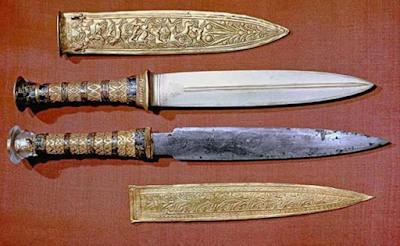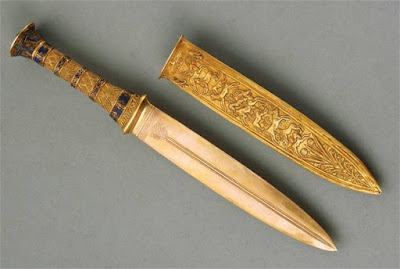Why Did Tutankhamun Have A Dagger Made From A Meteorite?
Scientists have long speculated that the ancient Egyptians used metal from meteorites to make iron objects. Now an analysis of a dagger found in Tutankhamun’s tomb has given us strong evidence that this was the case – and that the Egyptians knew the iron had come from the sky.
But why did they use such an unusual source for the metal when there’s plenty of iron here on Earth? Until recently, we didn’t think that the ancient Egyptians were particularly good at producing iron objects until late in their history, around 500 BC.
There’s no archaeological evidence for significant iron working anywhere in the Nile Valley. Even the large amounts of iron-rich smelting waste products found in the Delta region could actually have been produced by attempts to make copper. When Tutankhamun died – 800 years earlier – iron was a rarer material than gold.
Scientists have long speculated that the ancient Egyptians used metal from meteorites to make iron objects. Now an analysis of a dagger found in Tutankhamun’s tomb has given us strong evidence that this was the case – and that the Egyptians knew the iron had come from the sky.
But why did they use such an unusual source for the metal when there’s plenty of iron here on Earth? Until recently, we didn’t think that the ancient Egyptians were particularly good at producing iron objects until late in their history, around 500 BC.
There’s no archaeological evidence for significant iron working anywhere in the Nile Valley. Even the large amounts of iron-rich smelting waste products found in the Delta region could actually have been produced by attempts to make copper. When Tutankhamun died – 800 years earlier – iron was a rarer material than gold.
The
most common natural source of metal iron on Earth is iron ores – rocks
that contain iron chemically bonded to other elements.
These need to be processed by heating them with other materials (smelting) to extract a low-quality form of iron, which is then beaten with hammers to remove impurities. This requires considerable know-how, effort and tools that we have no evidence for in ancient Egypt.
There were abundant supplies of iron ore in both Egypt and the Sinai peninsula and textual sources indicate that Egyptians were aware of the metal from early in their history.
But the ore was mostly used to create pigments for art and make up. One explanation for this may be that the readily accessible iron ores were of poor quality so couldn’t be worked into more useful metal.
Tutankhamun's mummy was provided with two daggers encased in gold sheaths, one with an iron blade and the other with a blade of hardened gold. It is the latter specimen which is shown here.
As an illustration of the goldsmith's artistic ability and technical skill, this dagger, and particularly its sheath, are among the outstanding pieces of the collection.
On the top of the pommel are the king's cartouches in applied embossed gold and a wreath of lily-palmettes in cloisonne work.
On the underside are two figures of falcons holding in each claw the hieroglyphic symbol for 'eternity' (shen). The falcon was often represented in Egyptian art holding this symbol and, with wings outstretched, protecting a king.
These need to be processed by heating them with other materials (smelting) to extract a low-quality form of iron, which is then beaten with hammers to remove impurities. This requires considerable know-how, effort and tools that we have no evidence for in ancient Egypt.
There were abundant supplies of iron ore in both Egypt and the Sinai peninsula and textual sources indicate that Egyptians were aware of the metal from early in their history.
But the ore was mostly used to create pigments for art and make up. One explanation for this may be that the readily accessible iron ores were of poor quality so couldn’t be worked into more useful metal.
Tutankhamun's mummy was provided with two daggers encased in gold sheaths, one with an iron blade and the other with a blade of hardened gold. It is the latter specimen which is shown here.
As an illustration of the goldsmith's artistic ability and technical skill, this dagger, and particularly its sheath, are among the outstanding pieces of the collection.
On the top of the pommel are the king's cartouches in applied embossed gold and a wreath of lily-palmettes in cloisonne work.
On the underside are two figures of falcons holding in each claw the hieroglyphic symbol for 'eternity' (shen). The falcon was often represented in Egyptian art holding this symbol and, with wings outstretched, protecting a king.










No comments:
Post a Comment